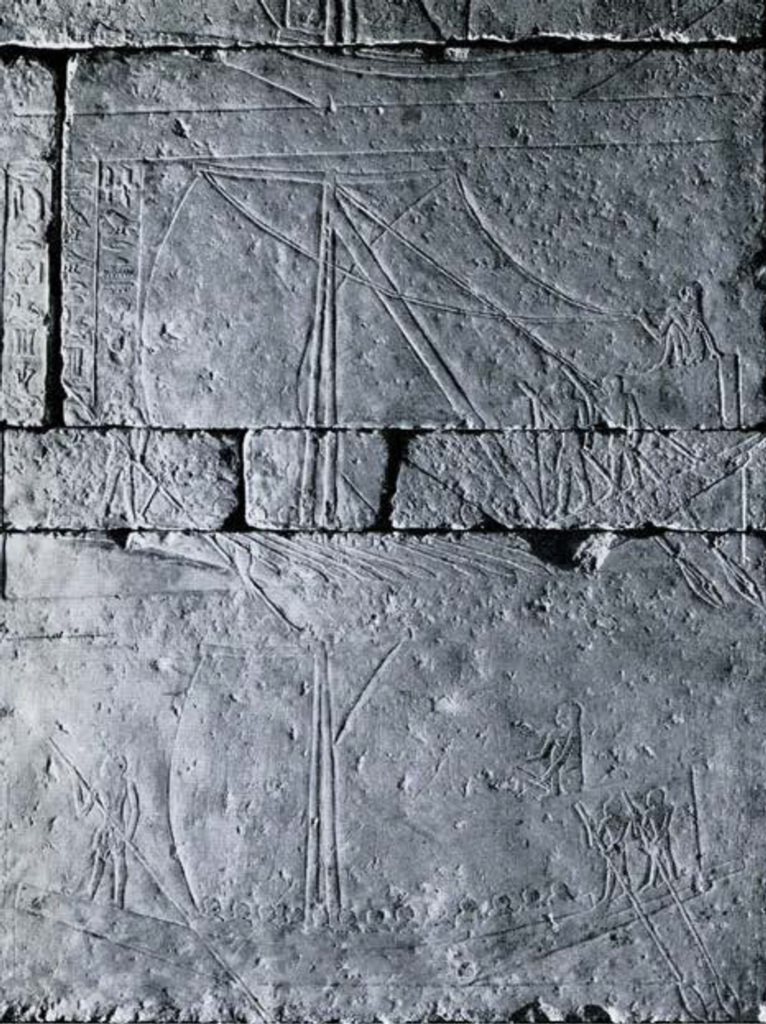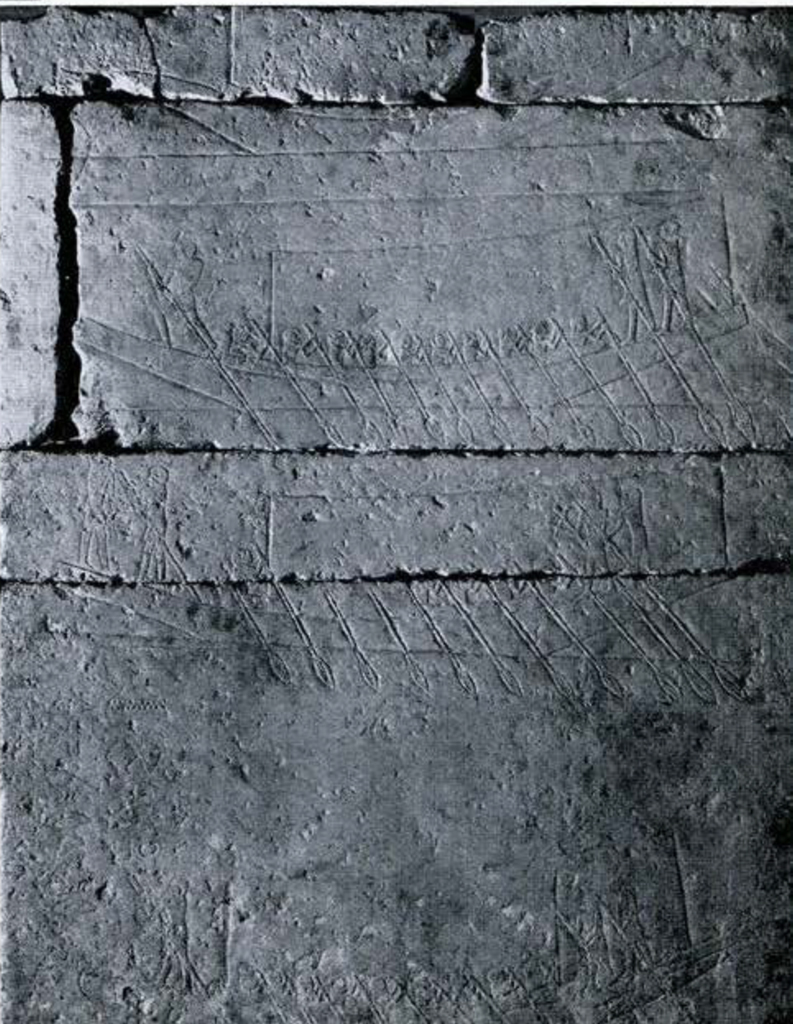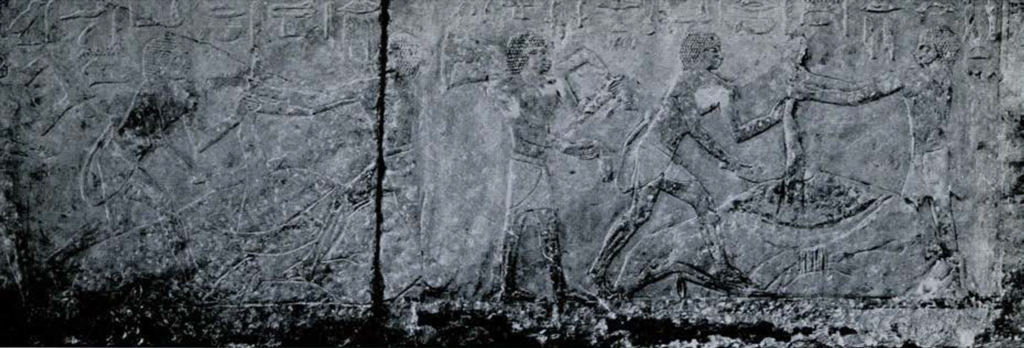THE offering chamber of this tomb, which is located at the southern end of the lower Egyptian hall, was described by Cornelia H. Dam in an article in the Museum Journal of June, 1927, Vol. XVIII, No. 2, entitled “The Tomb Chapel of Ra-Ka-Pou.”1 As a supplement to that article I thought it would be interesting to interpret some of the inscriptions which have a particular interest because they represent calls, commands, or conversations between some of the persons depicted in the wall scenes. Inscriptions of this nature are naturally difficult to translate on account of our ignorance of the way the Egyptians talked, and the grammatical difficulties which always arise when the spoken language is written down.

Museum Object Numbers: E15729
On each side of the entrance passage are low reliefs of ships (Plate XIV). At the top on each side is a light skiff made of papyrus. Below this on the right are two large wooden sailing ships with cabins; each has a man seated on the roof of the cabin, turning the spar of the sail to catch the wind. Both these ships have rowers as well as sails: in the upper one the rowers are working, and in the lower one they are resting. Each ship, including the rowing ships on the left side, has a man in front plying a punting pole, and at the back two men (who should be on each side of the ship) with steering paddles. The translation of the three columns of inscription beginning with the left hand column seems to be something like the following:
- “Give attention to the rope! The wind is behind thee again!”
- “Work hard! The wind ….”
- “To the west, to land in the middle!”
These are clearly orders called out by the captain; in (1) and (3) evidently to the man on the roof and in (2) to the crew at the oars.
On the left are three ships propelled by oars alone. The two columns of inscription read as follows:
- “Set to the west, (2) to land in the middle! Act all at once!”
This the first command is to the steersmen in the stern and the second to the oarsmen.

Museum Object Numbers: E15729
Inside the chamber the lower registers on the west, east and north walls, show men dismembering animals, and other men carrying the dismembered parts towards the false door (Figs. 4 and 5). To the right of the middle of this register on the west wall between the false door and the north wall is a butcher cutting off the leg of an animal with a large knife. Another man has a firm grasp of the leg with two hands and is pulling. Their conversation is recorded above them. The butcher says, “Pull!” His assistant says, “I will do it.” Back of the butcher stands a man with a haunch of meat over his left shoulder. His right hand is stretched towards the butcher and he is clearly in the attitude of a man speaking. He says, “Give meat of the forepart (or breast), the lector priest has come.” The lector priest took a prominent part in the funeral ceremonies. His duty appears to have been to read the ancient rituals. There are several lector priests depicted on the east wall behind the large standing figure of Kaipurē.
Passing to the right we see a similar group. The butcher’s assistant in this instance, however, is merely holding the leg firmly, and does not appear to be pulling. This is born out by the inscription. The butcher says, “Take hold!” His assistant answers, “I will do it so that you will approve it.” The man standing back of the butcher holds a haunch on his left shoulder and an object painted red in his right hand; from the inscription above we learn what it is: he says, “Give liver and spleen.”

Museum Object Numbers: E15729
On the north and east walls are similar scenes. Here, however, the conversation is varied a bit. Thus the butcher says, “Hold this, my comrade,” or “Pull this, my comrade,” and on the north wall we learn the nature of the animal, for the butcher says, “Hold this antelope!”
The second group from the left is entitled, “Taking out the heart.” The butcher at the left is bent over the animal and the assistant kneels at the right. The assistant appears to be steadying the animal. In a similar scene in another tomb of this period, he is catching the blood in a receptacle.
Such inscriptions bring us nearer to the real life of the Egyptians. It is a pity that only a comparative few have been left to us.
P. M.

Museum Object Numbers: E15729
1 According to our present knowledge, this name is now rendered Kaipurē, (“Rē is my ‘ka’ “), although it is written Rē-ka (i)-pu. The tendency of the ancient Egyptians of placing the name of a god first is known as honorific inversion. ↪

